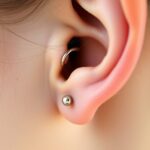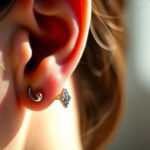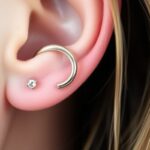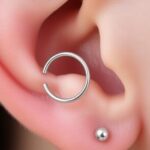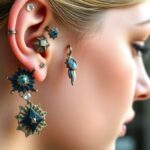When you think about the most challenging piercings, it's vital to take into account factors like anatomy, jewelry choice, and care. Industrial and snug piercings can be particularly tricky due to cartilage thickness and blood flow issues, often leading to longer healing times. Tragus piercings are prone to rejection if not placed correctly. Choosing the right jewelry is key; straight posts work well for helix piercings, while studs benefit conch piercings. Keeping a clean routine and monitoring progress is essential to avoid complications. If you're curious about overcoming these challenges, there's more to explore on this topic.
Key Takeaways
- Industrial piercings are challenging due to their dual cartilage involvement, leading to prolonged healing times and sensitivity issues.
- Upper ear cartilage piercings, like helix and conch, are prone to complications and require careful monitoring throughout the healing process.
- Tragus piercings face significant rejection and migration risks, necessitating precise placement to ensure successful healing.
- Jewelry choice is critical; straight posts are preferred for helix piercings, while conch piercings heal better with studs to reduce irritation.
- Individual anatomy plays a significant role in healing experiences, with thicker cartilage and limited blood flow complicating recovery for snug piercings.
Difficult Ear Piercings

When it comes to difficult ear piercings, you can't overlook the challenges they present during the healing process. An industrial piercing, which passes through two separate cartilage areas, tops the list for its complexity. Healing can take up to a year or longer due to its placement, making it essential to pay close attention during this time.
Other upper ear cartilage piercings, like helix and conch piercings, also pose significant healing difficulties. They're sensitive to contact, which can lead to complications even years after they've seemingly healed.
Snug piercings, located in thicker cartilage, face additional challenges due to limited blood flow, further increasing the risk of complications. Rook piercings can suffer from contact-related issues, while forward helix piercings complicate healing even more when done in multiples.
Although faux snug piercings tend to heal quickly if executed correctly, conch piercings showcase a wide variety in healing challenges, largely influenced by the type of jewelry used. Keeping these factors in mind will help you navigate the healing process more effectively and minimize complications.
Jewelry's Role in Healing

Choosing the right jewelry is essential for promoting healing in ear piercings. Jewelry's role in healing can't be overstated; it directly impacts your comfort and the speed of recovery.
For helix piercings, opt for straight posts instead of barbells. This choice minimizes complications and fosters better healing outcomes. It's important to take into account that certain materials, like titanium or surgical steel, can further enhance healing by reducing the risk of allergic reactions and irritation air purifiers for allergies.
When it comes to conch piercings, studs are your best bet. They outperform curved jewelry in enhancing healing efficiency.
Similarly, snug piercings benefit from jewelry that allows for some ear movement, reducing irritation and facilitating a smoother healing process.
Rigid jewelry can greatly impede healing by restricting movement and increasing irritation at the piercing site.
You'll want to avoid incorrect jewelry placement, as it can prolong healing times and raise the risk of complications and infections.
Anatomical Factors

Understanding how your anatomy influences the healing of piercings is vital to ensuring a smooth recovery. Anatomical variations can greatly impact the healing process of body piercings. For instance, cartilage thickness and blood flow play critical roles; piercings in areas like the snug and rook may face challenges due to limited circulation.
Here are some anatomical considerations to keep in mind:
- Rejection Risks: Tragus piercings are particularly susceptible to rejection and migration issues, making precise placement important.
- Sensitivity: Upper ear piercings, like helix and conch, can complicate healing due to their sensitivity to contact and irritation, often requiring specific jewelry.
- Shared Trauma: Multiple piercings, especially orbit piercings, may complicate healing by creating shared trauma and irritation.
Ultimately, your individual anatomy will dictate your healing experience. It's important to understand your unique body features when setting expectations for your piercing recovery.
Care and Monitoring Tips

Taking care of your new piercings is essential for a smooth healing process.
Regularly monitor them for any changes, maintain proper hygiene, and be mindful of your sleep position to avoid unnecessary pressure.
Importance of Regular Monitoring
Keeping an eye on your piercings is essential for ensuring a smooth healing process. Regular monitoring lets you track your healing progress and catch any potential complications early. By staying alert, you can intervene promptly if you notice issues like redness, swelling, or discharge, which can prevent more serious problems down the line.
Here are a few tips for effective monitoring:
- Take photos: Document your piercing's appearance regularly to spot changes over time.
- Ask for help: Have a friend check your piercing occasionally; fresh eyes can notice things you might miss.
- Tune in to your body: Pay attention to any discomfort or irritation, as these signs can indicate that adjustments in care or jewelry are needed.
Establishing a routine for checking your piercings helps maintain cleanliness and hygiene, reducing the risk of infection during the critical healing phase.
Engaging with the community can also provide valuable feedback and techniques that have worked for others.
Hygiene Practices for Healing
Hygiene is essential for the healing of your piercings, as it directly impacts the recovery process and helps prevent infections. For ear piercings, you should regularly monitor the area. Take photos or ask friends to check for any signs of complications, which will help you track the healing progress effectively.
Additionally, ensuring that you use appropriate jewelry materials, such as recommended materials, can also contribute to a smoother healing process.
Always wash your hands before touching your piercings to maintain cleanliness and avoid introducing bacteria. To minimize irritation, avoid unnecessary contact with the piercing and be cautious about your sleeping position to prevent pressure on the area.
Cleaning your piercings gently with saline solution or a recommended aftercare product is vital. However, don't over-clean, as this can irritate the healing tissue.
Make sure you educate yourself on the specific care requirements for your ear piercings. Different piercings have unique needs that can notably affect their healing process.
Sleep Position Considerations
Your sleep position plays an essential role in how well your new piercings heal, so it's important to be mindful of how you rest.
Sleeping directly on your new ear piercings can lead to irritation and complications, so consider adjusting your sleep habits during the healing process.
Here are some key sleep position considerations:
- Avoid Side Sleeping: If you're a side sleeper, try to sleep on your back until your piercings are fully healed. This helps prevent unnecessary pressure on your ears.
- Use a Travel or Specialty Pillow: These pillows can support your neck while keeping your head elevated, reducing contact with your fresh piercings.
- Keep Hair Away: Make sure your hair is secured back while you sleep to minimize the risk of irritation or infection from hair products and oils.
Additionally, take a moment each morning to monitor your piercings for any signs of irritation or infection.
Early detection can make a significant difference in your healing journey.
Community Insights

When it comes to healing, your experiences can really shed light on the challenges of different piercings.
Many folks in the community emphasize how anatomy and jewelry choices greatly influence recovery times.
Let's hear what you've faced and how your preferences shaped your healing journey.
Healing Experiences Shared
Steering the healing journey of piercings can be a shared experience among many in the community.
You'll discover that healing experiences vary greatly based on the type of piercing and your unique anatomy. For instance, industrial piercings often take a year or longer to heal due to anatomical challenges.
Likewise, snug piercings struggle due to their location in thick cartilage, which limits blood flow.
Here are key insights from fellow piercers:
- Jewelry Matters: Using the right type of jewelry is essential; rigid or incorrect pieces can irritate and prolong healing.
- Care Practices: Proper care, including avoiding pressure during sleep, greatly influences healing outcomes, especially for upper ear piercings like rook and forward helix.
- Individual Variability: Conch piercings show a wide range in healing experiences; some people recover quickly with suitable stud jewelry, while others may face difficulties with curved designs.
Anatomy-Related Challenges
Anatomy plays an essential role in how well piercings heal, and understanding this can help you navigate potential challenges. When it comes to body piercing, anatomical variations can lead to significant differences in healing experiences.
For instance, snug piercings may struggle due to thick cartilage and limited blood flow, making healing more complicated. Tragus piercings are particularly susceptible to rejection and migration issues; precise placement is critical to avoid these complications.
Additionally, upper ear piercings like helix and conch piercings face challenges due to their anatomical positioning and sensitivity to touch.
It's essential to recognize that your individual anatomy plays an important role in your healing journey. This means having realistic expectations about healing duration and possible complications based on your unique body structure.
Community insights reveal that piercings connecting multiple sites, such as orbit piercings, can complicate healing further. The interconnected nature of the jewelry adds stress to multiple areas, increasing the likelihood of issues.
Jewelry Preferences Discussed
Choosing the right jewelry for your piercings can greatly influence your healing experience and overall satisfaction. Piercers emphasize that selecting appropriate jewelry types can prevent complications and support quicker healing.
Here are some key jewelry preferences to take into account:
- For helix piercings, straight posts are recommended over barbells to enhance healing.
- Conch piercings benefit from studs instead of curved jewelry, fostering better healing outcomes.
- Rigid jewelry is discouraged; it can restrict ear movement and increase irritation.
In snug piercings, opt for jewelry that allows gentle movement with your ear, as this minimizes irritation and aids in healing.
A common mistake many make is switching out their jewelry too early. It's important to wait until your piercing is fully healed to avoid complications and infections.
Personal Healing Experiences

Healing from piercings, particularly industrials and cartilage types, can be a complex journey shaped by your unique anatomy and lifestyle choices.
If you've opted for an industrial piercing, brace yourself; it can take up to a year or longer to fully heal, especially if your ear anatomy isn't ideal for it. Many people face significant challenges with helix and conch piercings due to their sensitive cartilage, with healing times varying widely based on individual factors.
If you've chosen snug piercings, you might find the healing process even more complicated. The limited blood flow in thick cartilage increases the risk of complications.
Rook and forward helix piercings often come with their own set of issues, particularly from contact, which hinders the healing process.
Community feedback highlights that choosing the right jewelry is essential for your healing experience. For conch piercings, opting for studs instead of rigid jewelry can promote better recovery.
Frequently Asked Questions
What Is the Most Difficult Piercing?
When considering the most difficult piercing, you might find industrial piercings to be the toughest. They can take up to a year to heal due to their placement, making aftercare particularly essential for successful recovery.
What's the Hardest Piercing to Take Care Of?
When it comes to caring for piercings, the industrial one's often a real handful. You'll find it takes patience and diligence, as it can challenge your commitment to hygiene and healing over time.
What Piercings Look Unprofessional?
Certain piercings can come off as unprofessional in formal settings. Stretched lobes, visible facial piercings, or multiple piercings without coordination may create a chaotic look, while flashy jewelry can further detract from a professional appearance.
What Piercing Has the Highest Rejection Rate?
You'd think tragus piercings are the stars of durability, but ironically, they often face the highest rejection rates. Limited tissue and anatomical quirks make them prone to complications, so always choose wisely and consult a pro.
Conclusion
Maneuvering challenging piercings can feel like walking a tightrope—one misstep can lead to complications. As you consider your next piercing journey, remember the importance of choosing the right jewelry, understanding your anatomy, and following proper care techniques. Each person's healing experience is unique, but with the right insights and support, you can achieve a successful outcome. Embrace the adventure, listen to your body, and connect with the community to guarantee your piercing is a triumph, not a trial.



